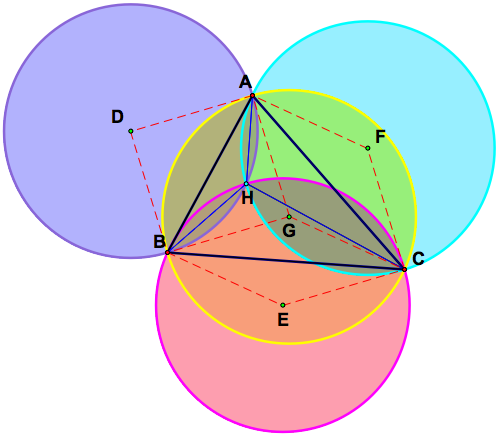Charlie Conway 7/22/2009
Orthocenters and Circumcircles
What happens if we begin with any triangle ABC and its orthocenter, H; then we make three more triangles, (AHB, BHC, CHA) for each one using two vertices and the orthocenter of the original triangle? Then let's say we construct the circumcircles for all four triangles, with circumcenters at D, E, and F, respectively. What relationships can we find among the circumcircles?
Click here for a GSP sketch of the situation.

Obvious Observations
The first and most obvious observation to make is that the dashed red lines coming from the circumcenters of each of the triangles subtending each corresponding side create an isosceles triangle. This is due to the fact that the dashed lines are radii of their respective circumcircle.
Another obvious fact is that all of the circumcircles, except for the circumcircle of triangle ABC intersect H. This is because the circles were constructed as circumcircles of the triangles AHB, BHC, CHA. And by definition the circumcircle contains all three vertices, H being a vertex in all three triangles.
Less Obvious Observations
The radii, and consequently the areas, of each circle in the picture are equal. This can be proven by measuring the arc lengths created by the legs of each triangle that have the original orthocenter as an endpoint, AH, BH, CH. Lets begin with the circumcircles for triangles AHB and BHC. The segment HB creates an arc length on both circles. When measured, these two arc lengths are the equal. Since the two circles have equal arc lengths subtended by the same segment, the must have equal area. We can make the same argument to show that the circumcircles for triangles BHC and CHA have equal area, and the circumcircles for triangles CHA and AHB have equal area. Also, each of these Circumcircles has the same area as the circumcircle for triangle ABC.
Each set of four radii subtending the same side of triangle ABC forms a rhombus. Without loss of generality, let us focus on triangle CHA. We have already shown that the radii for each of the circles is equal. Now to show a rhombus, we will prove that triangle CGA is congruent to triangle AFC. We know that the circumcircle for triangle ABC has the same area as the circumcircle for triangle CHA. The arcangle created by angle AFC on the circle with center F is equal to the arcangle created by AGC on the circle centered at G. Since we know these two circles have the same area, we know that angle AGC is equal to angle AFC. Therefore by Side-Angle-Side, triangle AGC is congruent to triangle AFC. Since segments AG, GC, CF, and FA are all equal, and angle AGC is equal to angle AFC, then AGCF is a rhombus. The same argument can be made to show that BGCE is a rhombus and that AHBD is a rhombus.
Click here to return to my homepage.